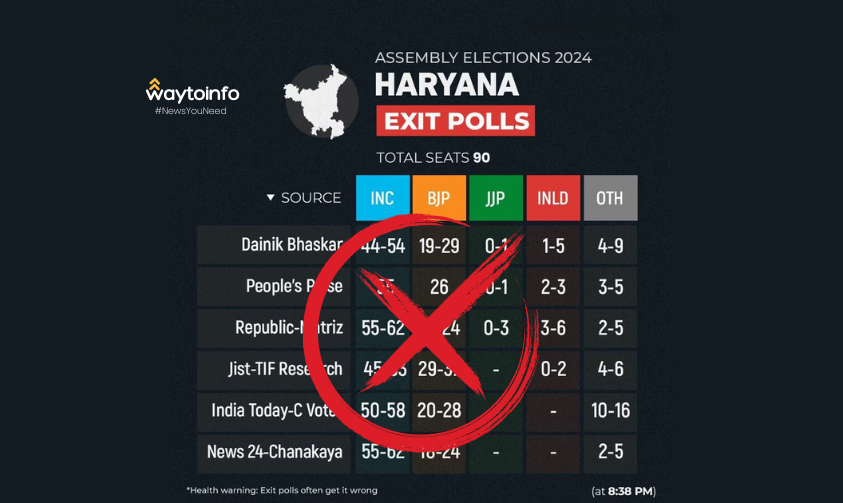
In the Haryana Assembly elections of 2024, the prospects of the voters had tasted massive interest, especially in the exit polls. But, as far as exit poll agencies are concerned, the earlier predictions failed and the public emerged much more skeptical. Looking for the explanation as to why the exit polls were wrong in this context, there are several factors, including, the methodological bias of exit polls, volatility of voters’ opinion, and the transforming of political context in Haryana.
Methodological Shortcomings
The method that is used in exit polls is one of the reasons that was causing so many inaccuracies in the results produced. A major limitation of many exit polls especially those that use pruning to estimate the electoral turnout is that they use sampling techniques that may be quite inaccurate. For example, if a pollster samples urban people, its results could be skewed from what most of the rural people of Haryana feel.
Sampling small lots carries the danger of inaccurate results since the conclusion is arrived at through the votes cast by a few people. The Economic Times reported that most of the exit polls that were conducted for the Haryana assembly polls tended to gauge the urban voter pulse and largely missed the rural voter because of which the election results were skewed.
Dynamic Voter Sentiment
Voter opinion is rather volatile and can shift depending on campaigning and politicking, political debates, or several policy pronouncements in the last few days. This dynamism is however most and more seen within the four walls of Haryana given the fact that regional politics, cast politics, and economics are very vital determiners of the voters. Perhaps election exit polls did not effectively capture this fluidity. For example, India Today pointed out a particularly crucial fact, that a large anti-incumbency working against the ruling party had surfaced only four days before the election and which was not displayed in the exit polls.
Social Media Influence
The part of social media in influencing opinion cannot be overemphasized. In Haryana, politicians from different parties started using social media primarily Twitter, Facebook, and Instagram to canvass their agenda and capture the voters. However, the feedback received through social media may be more representative of some sections of society in that the enthusiasts or the loud elements of an electorate may dominate the feedback.
Opinion pollsters may have failed to capture the digital sentiment correctly thereby resulting in over or under-estimation of some key candidature. Discussing the election period, The Hindu pointed out that inadequate attention was paid to the fact that a new wave of voters, who stormed social media, demonstrated quite different intentions.
Evolving Political Landscape
The political setup in the state of Haryana has been changing like the formation of a new political party/consolidation, all this has made the prediction aspect a bit tricky. It may also be because the regional parties and a new alliance can always change the voter base dramatically. It emerged that the exit polls did not consider the percentage disparity of the votes channeled to different forming parties hence producing wrong predictions. For instance, the increase in support for a new regional party or a coalition may result in a drastic shift in the predicted outcome, whereas exit polls may yet evolve to deliver this information.
The Impact of Last-Minute Campaigning
There is evidence that indicates the campaigns that are done in the last days before a particular election have an impact on the electorate. In Haryana, polling was crucial and after the initiation of a campaign by major parties within the state, all parties tried to woo the voters by coming up with all sorts of activities before the poll date in the hope that such acts would influence the floating voters.
Exit polls before this pivotal phase failed to identify these changes and the voter behavior hence there was always a difference between expectation and reality. The exit poll findings didn’t expect late rallies and public meetings to influence the support of the ruling party as reported.
Conclusion
Lessons from Haryana electoral experiments and exit polls reveal that there are relationships between methodology, voter feelings, societal factors, and the political context. Exit polls as many often may think, are not always accurate samples of the overall population and hence would not always accurately predict the sample. This unfortunate outcome suggests one of the reasons for inadequate sampling techniques and the inadequacy of understanding the electorate’s fluctuating sentiments in the Haryana region.
The refugees of any changes that political campaigns become are relevant to show that pollsters should tailor to these changes to increase dependability. That is why for voters the differences between exit polls and final results may cause doubts about the accuracy of these polls and therefore critical approach should be given to the assessment of poll predictions in future elections.
Read Also Visakha Railway Zone A Long-awaited Dream for Andhra Pradesh people
Leave a Reply